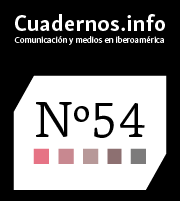Anime clustering for automatic classification and configuration of demographics
DOI:
https://doi.org/10.7764/cdi.54.53193Palabras clave:
Latent Dirichlet Allocation, Robot Process Automation, anime, modelaje de tópicos, clusterización, metodología, industria cultural, cultura pop japonesaResumen
The cultural industry assumed greater relevance as a productive system and expanded its market share with different forms of reception, transmission, and communication with the public, increasingly using the so called classification and recommendation algorithms and manipulation of mass processed data, which do not require cyber-physical systems for cataloging andconstant feedback from all parties involved for cataloging. In this regard, this paper proposes a methodology to support the classification and creation of corresponding groups, automatically, of cultural productions of certain segments through Robot Process Automation (RPA) techniques, to first extract public data created by fans of certain cultural segments, and Latent Dirichlet Allocation (LDA), for the clustering of these productions based on the data of the terms extracted by RPA. As a case study for this proposal, we specifically observed the anime market, defined as an originally Japanese cultural product with high fan engagement and high annual production scale, supported by data obtained from two public databases data: MyAnimeList and AniDB, built collaboratively by fans. The application of the methodology allowed the automatic classification of anime, grouping them into topics that allow the proposal of a new demography of products of this genre in relation to the current one, providing a greater level of detail and allowing to contemplate the expansion of new themes.
Descargas
Citas
Anderson, C. (2006). The Long Tail: Why the Future of Business is Selling Less of More. Hachette Books.
Azuma, H. (2009). Otaku: Japan's Database Animals. University of Minnesota Press.
Blei, D. M., Ng, A. Y., & Jordan, M. I. (2003). Latent Dirichlet Allocation. Journal of Machine Learning Research. 3, 993–1022. https://dl.acm.org/doi/10.5555/944919.944937
Bryce, M., & Davis, J. (2010). Manga: An Anthology of Global and Cultural Perspectives. A&C Black.
Brzeski, P. (2022, May 16). Cannes: How Japanese Anime Became the World’s Most Bankable Genre. The Hollywood Reporter. https://www.hollywoodreporter.com/business/businessnews/cannes-japanese-anime-worlds-most-bankable-genre-1235146810/
Butler, C. (2019). Shoujo Versus Seinen? Address and Reception in Puella Magi Madoka Magica (2011). Children's Literature in Education, 50, 400-416. https://doi.org/10.1007/s10583-018-9355-9
Condry, I. (2013). The Soul of Anime: Collaborative Creativity and Japan’s Media Success Story. Duke University Press.
Galbraith, P. W. & Schodt, F. L. (2009). The Otaku Encyclopedia: An Insider's Guide to the Subculture of Cool Japan. Kodansha International.
Glez-Peña, D., Lourenço, A., López-Fernández, H., Reboiro-Jato, M., & Fdez-Riverola, F. (2014). Web scraping technologies in an API world. Briefings in Bioinformatics, 15(5), 788-797. https://doi.org/10.1093/bib/bbt026
Hui, Y. (2016). On the Existence of Digital Objects. University of Minnesota Press. Iwabuchi, K. (2002). Recentering Globalization: Popular Culture and Japanese Transnationalism. Duke University Press.
Jenkins, H., Ford, S., & Green, J. (2013). Spreadable Media. New York University Press.
Katsuno, H. & Maret, J. (2004). Localizing the Pokémon TV Series for the American Market. In J. Tobin (Ed.), Pikachu’s Global Adventure: The Rise and Fall of Pokémon (pp. 80–107). Duke University Press.
Marres, N. & Weltevrede, E. (2013). SCRAPING THE SOCIAL?: Issues in live social research. Journal of Cultural Economy, 6(3), 313–335. https://doi.org/10.1080/17530350.2013.772070
Mitcham, C. (1994). Thinking through Technology: The Path between Engineering and Philosophy. The University of Chicago Press.
Mhatre, M., Phondekar, D., Kadam, P., Chawathe, A., & Ghag, K. (2017). Dimensionality reduction for sentiment analysis using pre-processing techniques. In 2017 International Conference on Computing Methodologies and Communication (ICCMC) (pp. 16-21). IEEE. https://doi.org/10.1109/ICCMC.2017.8282676
Mullakara, N., & Asokan, A. K. (2020). Robotic process automation projects: build real-world RPA solutions using UiPath and automation anywhere. Packt Publishing.
Nijhawan, T., Attigeri, G., & Ananthakrishna, T. (2022). Stress detection using natural language processing and machine learning over social interactions. Journal of Big Data, 9, 33. https://doi.org/10.1186/s40537-022-00575-6
Orsini, L. (2018, May 30) MyAnimeList passes Third Day of Unexpected Downtime. Forbes. https://www.forbes.com/sites/laurenorsini/2018/05/30/myanimelist-passes-third-dayof-unexpected-downtime/?sh=36c56d987e9e
Pineda, R. A. (2021, November 7). AJA: anime industry contracted 3.5% in 2020: overseas market overtakes domestic market for 1st time. Anime News Network. https://www.animenewsnetwork.com/news/2021-11-07/aja-anime-industry-contracted-3.5-percent-in-2020/.179142
Saitou, T. & Azuma, H. (2011). Beautiful Fighting Girl. University of Minnesota Press.
Scolari, C. A. (2018). Las leyes de la interfaz: diseño, ecología, evolución, tecnología (The laws of the interface: design, ecology, evolution, technology). Editorial Gedisa.
Tripathi, A. M. (2018). Learning Robotic Process Automation: Create Software robots and automate business processes with the leading RPA tool–UiPath. Packt Publishing.
Urbano, K. & Araujo, M. (2021). O fluxo midiático dos animês e seus modelos de distribuição e consumo no Brasil (Anime’s media flow and the distribution and consumption’s models in Brazil). Ação Midiática – Estudos em Comunicação, Sociedade e Cultura, (21), 81-101. https://revistas.ufpr.br/acaomidiatica/article/view/71589
Van der Aalst, W. M., Bichler, M., & Heinzl, A. (2018). Robotic Process Automation. Business & Information Systems Engineering, 60, 269-272. https://doi.org/10.1007/s12599-018-0542-4
Zhang, W., Yoshida, T., & Tang, X. (2011). A comparative study of TF*IDF, LSI and multiwords for text classification. Expert Systems with Applications, 38(3), 2758-2765. https://doi.org/10.1016/j.eswa.2010.08.066
Zhao, W., Chen, J. J., Perkins, R., Liu, Z., Ge, W., Ding, Y., & Zou, W. (2015). A heuristic approach to determine an appropriate number of topics in topic modeling. BMC Bioinformatics, 16, S8. https://doi.org/10.1186/1471-2105-16-S13-S8
Descargas
Publicado
Cómo citar
Número
Sección
Licencia
Derechos de autor 2023 Julio Cesar Valente Ferreira, Thiago Ribeiro Furtado, Rafael Dirques David Regis, Gabriela Rodrigues Diniz, Paula Gonçalves, Vitor Pedro da Silva Castelo Tavares

Esta obra está bajo una licencia internacional Creative Commons Atribución-NoComercial-CompartirIgual 4.0.















